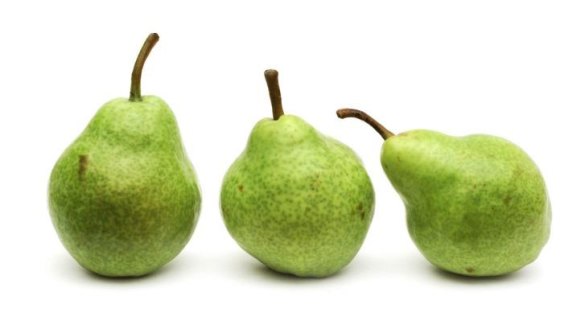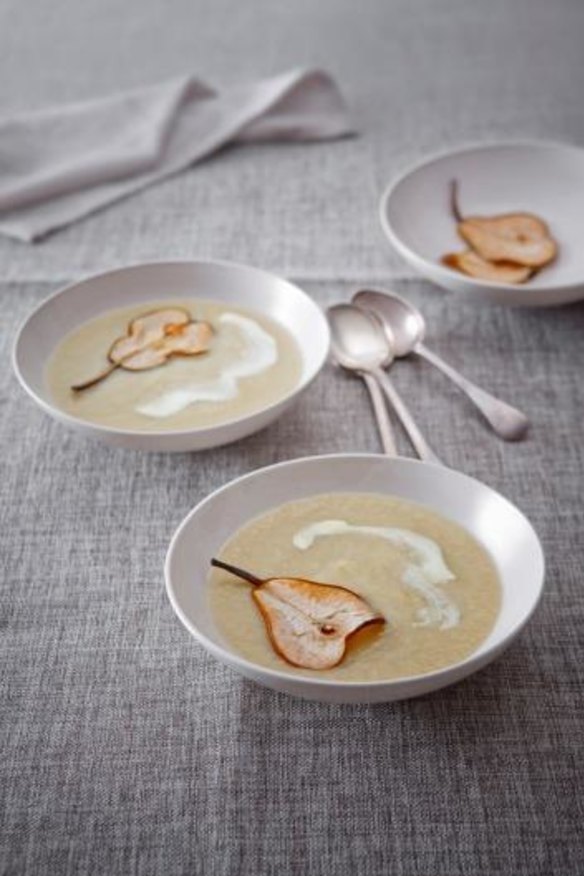Owen Pidgeon: How to make most of pear season in Canberra

The season of pears has arrived and so we can now enjoy the sweet taste of fresh, ripe pears which ooze with juice. We can also open up our favourite recipes for the pears that can be poached, roasted and baked.
You can enjoy a fruit that goes way back into antiquity, when the early improved varieties were developed by the Phoenicians and Romans. However we should show our most gratitude to the monasteries and dedicated breeders of northern France and Belgium, during the 18th and 19th centuries, for growing and selecting the fine culinary varieties that we can eat today.
If you are ever visiting Paris and can make a day trip to Versailles, don't just visit the Palace and its surrounding gardens. Take two hours to go into the town and find the Potager du Roi (the Garden of the King) which is situated beside the main Catholic church. There you can see the finest collection of French pear and apple trees, with many more varieties of pears than apples.

European pears are different from most other fruits in that they ripen from inside out and they will complete their maturing best if picked slightly unripe then stored at a low temperature. If you think that the pears in question are close to maturity, then select a small one and cut it in half. If the pips have turned black but the skin is beginning to colour up, then carefully pick off your crop. Always keep the stem intact with the pear. Pick off your fruit by gently twisting the stem upwards.
Store in a very cool place, or refrigerated, for 10-14 days to allow the fruit to ripen further and develop its sweetness
Throughout history, breeding programs would have needed to allow 15 and 20 years to achieve the desired result of producing a fine new variety. The breeders would select two parent cultivars with known features and plant them in rows, far away from other potential pollinators. They would wait for these trees to produce fruit which would be selected for "growing on and testing" and the rest would be culled.
Final releases of varieties into the commercial market require endorsement on texture and taste, appearance, regularity in cropping and its ability to store well. Today we are able to buy many of the finest pears in the world.
The two main varieties coming onto the new season market now are the Packhams Triumph and the Beurre Bosc pears. We also have a small crop of USA origin Potomac and Howell pears that are ripening now. They will be closely followed by the wonderful Rouge d'Anjou pear.
Packhams triumph is a very local pear, found in the orchard of Mr C. H. Packhams in the mid-20th century. It has been determined to have come from the crossing of a Uvedale St Germain pear with a Williams pear.
The beurre bosc pear was a product of the northern France/southern Belgium breeding program in the 19th century. It has taken its name from the long-serving director of the Paris Botanical Gardens, Monsieur Bosc.
This pear is sweet and buttery when ripe (hence its generic name in French). Its inherent denseness means that it is ideal for cooking, baking and poaching. You will often see this pear recommended for use in pear desserts and for pear cakes.
The Howell pear was bred in New Haven, Connecticut by Mr T. Howell in 1840 and has become one of the most famous American varieties. It is quite large in size with an attractive smooth light green skin which turns pale yellow on maturity. It has a firm but juicy flesh with a buttery flavour. It is a heavy-bearing variety so that the branches will need to be supported or they could break off as the weight of the maturing pears keeps increasing. Howell pears need to be stored for at least two weeks after picking, to properly sweeten up.
Potomac is the famous river which flowed beside the battleground of the American Civil War. It fascinates me that the newly developed pear carried this name because it was bred in 1993 by scientists in West Virginia, combining with the Ohio State University. It is a medium sized, light green pear. Its flesh is creamy white, delicate and juicy.
The d'Anjou pear is from the royal heritage of the French kings of Anjou. It was bred by the French in the mid-19th century and found its way to the US by the year 1852. It was brought into Australia in the mid 1990s by ANFIC (the fruit improvement corporation). We have been fortunate in securing a supply of the red skinned Rouge d'Anjou. It is very sweet, delicious to eat fresh and a good keeper. A highly sought after pear and truly one of my most favourite pears.
The specialist pear propagating nurseries in Australia are now making available several other famous European pears, including the English Conference pear, and the French Doyenne du Comice, Beurre Hardy and Angelys. Belgium pears of distinction include the Glou Mourceau and the Dorondeau. The Lemon Bergamot is also a delightful small pear, which is grown widely in the south of Italy.
So there are pears for every purpose and to satisfy every taste bud. Enjoy fully ripe pears and avoid overly green and unripe ones that sometimes appear in bulk sales. They just give this wonderful fruit a bad reputation.
SPICY SWEET POTATO AND PEAR SOUP
500g sweet potato
2 large Beurre Bosc pears
1 tbs olive oil
1 onion, finely chopped
2 cloves garlic, crushed
2 tsp chilli powder
½ tsp paprika
4 cups vegetable stock
salt and pepper to taste
Peel and chop the sweet potato into cubes. Peel, core and cube the pears. Heat the oil in heavy based saucepan and fry onion and garlic until soft. Add pears, sweet potato and spices and fry to brown. Add in the vegetable stock and simmer until pear and sweet potato are soft. Remove from heat and blend. Return to pot and reheat. Season with salt and pepper and serve with crusty bread.
This week in the garden
* Plant a row of silver beet and spinach, some chives and a bed of oregano.
* Continue plant a selection of loose leaf lettuces, beetroot and sugar loaf and savoy cabbage seedlings.
* Keep regularly watering fruit trees and berries, as well as all vegetable gardens, to avoid water stress with this long dry spell.
* Clean out summer vegetable crops that have finished and where they have been gross feeders, replant with shelling peas, sugar snap peas and snow peas.
* Keep up a regular garden cleaning program, not just with the weeds that are growing so fast, but also gathering up all fallen fruit and tomatoes.
Owen Pidgeon runs the Loriendale Organic Orchard near Hall.
The best recipes from Australia's leading chefs straight to your inbox.
Sign up